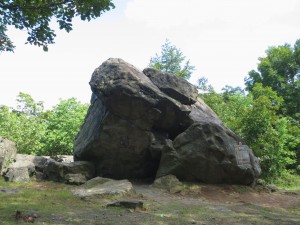 Two English judges who fled a royal death sentence are honored at their hiding place high above New Haven.
Two English judges who fled a royal death sentence are honored at their hiding place high above New Haven.
Judges Cave, at the summit of West Rock State Park, is a large rock formation that, to be fair, stretches the common idea of what a cave looks like.
New Haven’s quasi-cave was the hiding place of Edward Whalley and William Goffe, who were among 59 members of Parliament who signed the warrant condemning King Charles I to death in 1649.
That probably seemed like a good idea until the monarchy was restored in 1660 and Charles II ordered the execution of the judges who had had his father beheaded.
The west face of the rock formation bears a marker reading, “Here May Fifteenth 1661 and for some weeks thereafter Edward Whalley and his son-in-law William Goffe, members of the Parliament General, officers in the army of the Commonwealth and signers of the death warrant of King Charles First, found shelter and concealment from the officers of the Crown after the Restoration. ‘Opposition to tyrants is obedience to God.'”
 The marker on the west face is a replacement for a bronze plaque on the east face that was dedicated in 1896 and later stolen. (The original plaque can be seen in the black-and-white image, which was taken in 1900).
The marker on the west face is a replacement for a bronze plaque on the east face that was dedicated in 1896 and later stolen. (The original plaque can be seen in the black-and-white image, which was taken in 1900).
After fleeing England, Whalley and Goffe stayed briefly in Massachusetts before learning that agents of the Crown were looking for them. In New Haven, they were sheltered by Rev. John Davenport (the city would name streets after all three gentlemen) before hiding atop West Rock.
Their stay at the rock formation lasted about a month before Whalley and Goffe were chased from the cave by a panther. They moved again and resettled in Hadley, Mass.
 The site today can be reached by car, or hikers can find it along the Regicides Trail (the excellent Connecticut Museum Quest site offers a good description of a Judges Cave hike). An overlook area a short drive from the cave provides nice views of downtown New Haven and the harbor.
The site today can be reached by car, or hikers can find it along the Regicides Trail (the excellent Connecticut Museum Quest site offers a good description of a Judges Cave hike). An overlook area a short drive from the cave provides nice views of downtown New Haven and the harbor.
Tags: New Haven


